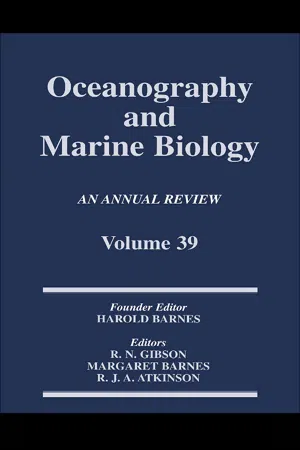
eBook - ePub
Oceanography and Marine Biology
An Annual Review: Volume 39
This is a test
- 448 pages
- English
- ePUB (mobile friendly)
- Available on iOS & Android
eBook - ePub
Book details
Book preview
Table of contents
Citations
About This Book
Interest in oceanography and marine biology and the relevance of those fields to global environmental issues creates a demand for authoritative reviews that summarize recent research. Oceanography and Marine Biology: an Annual Review has catered to this demand since its foundation, by the late Harold Barnes, more than 35 years ago. It is an annual
Frequently asked questions
At the moment all of our mobile-responsive ePub books are available to download via the app. Most of our PDFs are also available to download and we're working on making the final remaining ones downloadable now. Learn more here.
Both plans give you full access to the library and all of Perlego’s features. The only differences are the price and subscription period: With the annual plan you’ll save around 30% compared to 12 months on the monthly plan.
We are an online textbook subscription service, where you can get access to an entire online library for less than the price of a single book per month. With over 1 million books across 1000+ topics, we’ve got you covered! Learn more here.
Look out for the read-aloud symbol on your next book to see if you can listen to it. The read-aloud tool reads text aloud for you, highlighting the text as it is being read. You can pause it, speed it up and slow it down. Learn more here.
Yes, you can access Oceanography and Marine Biology by R. N. Gibson, R. N. Gibson, R. N. Gibson in PDF and/or ePUB format, as well as other popular books in Biological Sciences & Marine Biology. We have over one million books available in our catalogue for you to explore.
Information
TERRITORIAL DAMSELFISHES AS
DETERMINANTS OF THE STRUCTURE OF
BENTHIC COMMUNITIES ON CORAL REEFS
DANIELA M.CECCARELLI,1 GEOFFREY P.JONES,2
& LAURENCE J.McCOOK3
1Department of Marine Biology and Aquaculture, James Cook University,
Townsville, 4811, Queensland, Australia
e-mail: [email protected]
2 Department of Marine Biology and Aquaculture, James Cook University,
Townsville, 4811, Queensland, Australia
e-mail: [email protected]
3 Australian Institute of Marine Science & CRC: Reef Research, PMB3,
Townsville, MC, 4810, Queensland, Australia
e-mail: [email protected]
Abstract This review evaluates the generalisation that territorial, herbivorous damselfishes (Pomacentridae) have a major influence on the structure of algal, coral, other invertebrate and fish assemblages on coral reefs. Herbivorous damselfishes are a diverse, widespread and abundant component of reef fish assemblages and their territories take up a significant proportion of the shallow reef substratum. There are several mechanisms by which they potentially affect community structure within territories, including both food consumption and potential “farming” activities, such as “weeding” of undesirable organisms, “killing” coral to grow algae, providing nutrients for algal “crops” and the aggressive “defence” of vital resources.
A synthesis of the literature that documents assemblages both inside and outside territories revealed a number of common patterns. Erect filamentous algae often dominate territories, whereas low-lying crustose coralline and prostrate algae characterise adjacent areas. Furthermore, territories consistently support a greater biomass, productivity and species richness of algae than undefended areas. Experimental studies suggest that damselfishes modify regimes of disturbance and succession but the potentially different effects of feeding, farming and territorial exclusion suggest a more complex interaction of processes. There are also substantial differences between defended and undefended areas in coral species composition and densities of small, mobile organisms such as cryptofauna and juvenile fishes, whereas larger herbivorous fishes are excluded from territories. However, the larger-scale effects of these interactions on the ecology of “included” or “excluded” species has yet to be examined.
Many of the above generalisations may be premature as the literature is clearly biased towards a few larger, more aggressive species that maintain conspicuous algal mats. Our review draws attention to the numerically more abundant and less aggressive herbivorous species whose effects appear to be less dramatic. Furthermore, the spatial and temporal variability in the structure of damselfish communities is largely unknown, further restricting our ability to make valid generalisations. While the effects of territoriality have been tested by damselfish removals, more sophisticated experimental work is needed to assess the relative contributions of selective feeding, reduced herbivory, weeding and other farming activities. These mechanisms will be clearer if we have a better understanding of the function of territoriality, the actual benefits of algal turfs to the damselfishes and the separate tasks involved with establishing and maintaining territories.
Introduction
It is widely acknowledged that herbivorous fishes have a major influence on the structure of benthic communities on coral reefs (Choat 1982, Steneck 1988, Horn 1989, Glynn 1990, Hay 1991, Hixon 1996). Although herbivores usually comprise <25% of the total fish species diversity and biomass (Randall 1961, Ogden & Lobel 1978, Meekan & Choat 1997), this low percentage does not reflect their ecological importance relative to other trophic groups. Grazing activities appear to control the standing crops of many dominant reef algae (Wanders 1977, Carpenter 1986, Steneck 1988, Hay 1991, Pennings 1996, McCook 1996, 1997, Miller 1998, Russ & McCook 1999). Where large herbivores have been excluded or removed through over-fishing, macroalgae have been reported to overgrow reefs and reduce live coral cover (Wanders 1977, Hughes 1994, Hay 1997, re...
Table of contents
- Cover Page
- Title Page
- Copyright Page
- Preface
- Life-History Patterns In Serpulimorph Polychaetes: Ecological and Evolutionary Perspectives
- Molluscs As Archives of Environmental Change
- The Evolution of Eyes In the Bivalvia
- Practical Measures of Marine Biodiversity Based On Relatedness of Species
- Functional Group Ecology In Soft-Sediment Marine Benthos: The Role of Bioturbation
- The Importance of Seagrass Beds As a Habitat for Fishery Species
- Selective Tidal-Stream Transport of Marine Animals
- Territorial Damselfishes As Determinants of the Structure of Benthic Communities On Coral Reefs